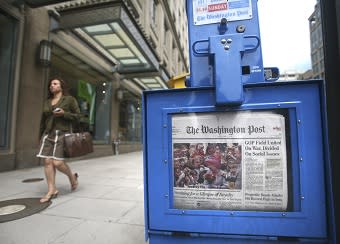 The Upshot
The UpshotWashington Post to start running front-page ads

Washington Post readers in the D.C.-metro area probably noticed a Capital One-sponsored advertisement wrapped around Sunday's paper. The removable wrap, which covered half the front page and all of the back page, was an advertising first for the newspaper.
But there's another first coming this Sunday: The Post will run a display ad on the bottom of the actual front page.
"A number of other newspapers have done it as well," said Wendy Evans, the Post's vice president of advertising. "It's not new in the industry, but new to us."
Indeed, the Post has been something of a holdout from the general embrace of front-page newspaper ads, as advertising revenue has sharply dropped for all print publications in recent years. Several major newspapers now run front-page display ads, including the Wall Street Journal, Los Angeles Times, and the New York Times — with the latter paper starting to run front-page ads just last year.
Newspaper executives and editors pride themselves on maintaining a church/state wall between editorial and advertising and their traditional reluctance to sell front page ads stemmed largely from the sense that they appeared to broach that wall — sending the message to readers and advertisers that the front page, which editors have long viewed as their own sacrosanct turf, would essentially be up for sale. But harsh economic struggles have forced newspaper companies to get more creative when it comes to generating revenue. And with its inaugural front-page ad scheduled for next Sunday, the Post is showing that it's no exception.
The paper has been burned by other innovations that appeared to permeate the advertising/editorial wall. Last year, Post publishing officials got into hot water for planning to hold a series of revenue-generating "salons" that would have made Post reporters available to lobbyists and industry representatives involved in key issues like health care reform. News of those events spurred critics to question whether powerful lobbyists could buy access to the paper's top editors, publishers, and reporters. The episode showed a clear breakdown in the Post's long-standing practice of safeguarding the editorial product from commercial interests.
Evans told The Upshot that Post editorial and advertising hands took part in internal discussions before committing to the Capital One campaign, including whether the ad made sense for the news and advertising departments, while also taking into account the needs of readers. The campaign, she noted, is targeted locally and informs Chevy Chase Bank customers — some of whom may be Post readers — that their neighborhood branches will be rebranded as Capital One banks. So, presumably, the ad may serve the public's interest while also bringing in money for the Post.
However, Evans declined to discuss prices for this past Sunday's wrap or this coming Sundays' front-page ad, which will be a two-inch strip at the bottom of the page. Yesterday, that space was filled with a quote from the Post's profile of new Redskins coach Mike Shanahan. Next week, Post editors won't have that space to work with when laying out the front page.
As it moves ahead with the experiment, the Post will probably heed some miscues on the part of rival papers who've strayed into uncomfortable territory in the pursuit of front-page ad revenue. Last year, the Los Angeles Times drew criticism for running a front-page ad for NBC's "Southland" that too closely resembled a Times news story. The same paper also made the controversial decision to publish a mock front page promoting Disney's film "Alice in Wonderland" over the actual front page.
(Photo: AP/ Lawrence Jackson)

